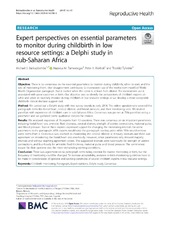Expert perspectives on essential parameters to monitor during childbirth in low resource settings: A Delphi study in sub-Saharan Africa
Peer reviewed, Journal article
Published version

Åpne
Permanent lenke
https://hdl.handle.net/1956/23496Utgivelsesdato
2019-08-05Metadata
Vis full innførselSamlinger
Originalversjon
https://doi.org/10.1186/s12978-019-0786-6Sammendrag
Objective: There is no consensus on the essential parameters to monitor during childbirth, when to start, and the rate of monitoring them. User disagreement contributes to inconsistent use of the twelve-item modified World Health Organization partograph that is started when the cervix is at least 4 cm dilated. The inconsistent use is associated with poor outcomes at birth. Our objective was to identify the perspectives of childbirth experts on what and when to routinely monitor during childbirth in low resource settings as we develop a more acceptable childbirth clinical decision support tool. Method: We carried out a Delphi study with two survey rounds in early 2018. The online questionnaire covered the partograph items like foetal heart, cervical dilation, and blood pressure, and their monitoring rates. We invited panellists with experience of childbirth care in sub-Saharan Africa. Consensus was pre-set at 70% panellists rating a parameter and we gathered some qualitative reasons for choices. Results: We analysed responses of 76 experts from 13 countries. There was consensus on six important parameters including foetal heart rate, amniotic fluid clearness, cervical dilation, strength of uterine contractions, maternal pulse, and blood pressure. Two in three experts expressed support for changing the monitoring intervals for some parameters in the partograph. 63% experts would raise the partograph starting point while 58% would remove some items from it. Consensus was reached on monitoring the cervical dilation at 4-hourly intervals and there was agreement on monitoring the foetal heart rate one-hourly. However, other parameters only showed majority intervals and without reaching agreement scores. The suggested intervals were two-hourly for strength of uterine contractions, and four-hourly for amniotic fluid thickness, maternal pulse and blood pressure. The commonest reason for their opinions was the more demanding working conditions. Conclusion: There was agreement on six partograph items being essential for routine monitoring at birth, but the frequency of monitoring could be changed. To increase acceptability, revisions to birth monitoring guidelines have to be made in consideration of opinions and working conditions of several childbirth experts in low resource settings.
